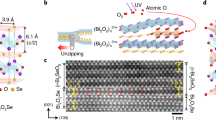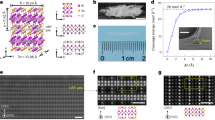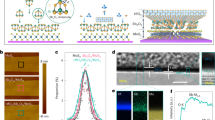Abstract
Silicon-based transistors are approaching their physical limits and thus new high-mobility semiconductors are sought to replace silicon in the microelectronics industry. Both bulk materials (such as silicon-germanium and III–V semiconductors) and low-dimensional nanomaterials (such as one-dimensional carbon nanotubes and two-dimensional transition metal dichalcogenides) have been explored, but, unlike silicon, which uses silicon dioxide (SiO2) as its gate dielectric, these materials suffer from the absence of a high-quality native oxide as a dielectric counterpart. This can lead to compatibility problems in practical devices. Here, we show that an atomically thin gate dielectric of bismuth selenite (Bi2SeO5) can be conformally formed via layer-by-layer oxidization of an underlying high-mobility two-dimensional semiconductor, Bi2O2Se. Using this native oxide dielectric, high-performance Bi2O2Se field-effect transistors can be created, as well as inverter circuits that exhibit a large voltage gain (as high as 150). The high dielectric constant (~21) of Bi2SeO5 allows its equivalent oxide thickness to be reduced to 0.9 nm while maintaining a gate leakage lower than thermal SiO2. The Bi2SeO5 can also be selectively etched away by a wet chemical method that leaves the mobility of the underlying Bi2O2Se semiconductor almost unchanged.
This is a preview of subscription content, access via your institution
Access options
Access Nature and 54 other Nature Portfolio journals
Get Nature+, our best-value online-access subscription
$29.99 / 30 days
cancel any time
Subscribe to this journal
Receive 12 digital issues and online access to articles
$119.00 per year
only $9.92 per issue
Buy this article
- Purchase on Springer Link
- Instant access to full article PDF
Prices may be subject to local taxes which are calculated during checkout




Similar content being viewed by others
Data availability
The data that support the plots within this paper and other findings of this study are available from the corresponding author upon reasonable request.
References
Kilby, J. S. Invention of the integrated circuit. IEEE Trans. Electron. Dev. 23, 648–654 (1976).
Kingon, A. I., Maria, J. P. & Streiffer, S. K. Alternative dielectrics to silicon dioxide for memory and logic devices. Nature 406, 1032–1038 (2000).
Muller, D. A. et al. The electronic structure at the atomic scale of ultrathin gate oxides. Nature 399, 758–761 (1999).
Van Zant, P. Microchip Fabrication: A Practical Guide to Semiconductor Processing 4th edn, 100–121 (McGraw Hill, 2000).
Ferain, I., Colinge, C. A. & Colinge, J. P. Multigate transistors as the future of classical metal–oxide–semiconductor field-effect transistors. Nature 479, 310–316 (2011).
Aberg, I., Chleirigh, C. N., Olubuyide, O. O., Duan, X. & Hoyt, J. L. High electron and hole mobility enhancements in thin-body strained Si/strained SiGe/strained Si heterostructures on insulator. In Technical Digest of the IEEE International Electron Devices Meeting 2004 173–176 (IEEE, 2004).
Xiang, J. et al. Ge/Si nanowire heterostructures as high-performance field-effect transistors. Nature 441, 489–493 (2006).
Passlack, M. et al. High mobility III–V MOSFETs for RF and digital applications. In Proceedings of the International Electron Devices Meeting 2007 621–624 (IEEE, 2007).
Ohtomo, A. & Hwang, H. Y. A high-mobility electron gas at the LaAlO3/SrTiO3 heterointerface. Nature 427, 423–426 (2004).
Qiu, C. G. et al. Scaling carbon nanotube complementary transistors to 5-nm gate lengths. Science 355, 271–276 (2017).
Shulaker, M. M. et al. Carbon nanotube computer. Nature 501, 526–530 (2013).
Desai, S. B. et al. MoS2 transistors with 1-nanometer gate lengths. Science 354, 99–102 (2016).
Li, L. K. et al. Black phosphorus field-effect transistors. Nat. Nanotechnol. 9, 372–377 (2014).
Bandurin, D. A. et al. High electron mobility, quantum Hall effect and anomalous optical response in atomically thin InSe. Nat. Nanotechnol. 12, 223–227 (2017).
Novoselov, K. S. et al. A roadmap for graphene. Nature 490, 192–200 (2012).
Chhowalla, M., Jena, D. & Zhang, H. Two-dimensional semiconductors for transistors. Nat. Rev. Mater. 1, 16052 (2016).
Franklin, A. D. Nanomaterials in transistors: from high-performance to thin-film applications. Science 349, aab2750 (2015).
Li, M. Y., Su, S. K., Wong, H. S. P. & Li, L. J. How 2D semiconductors could extend Moore’s law. Nature 567, 169–170 (2019).
Liu, Y., Duan, X. D., Huang, Y. & Duan, X. F. Two-dimensional transistors beyond graphene and TMDCs. Chem. Soc. Rev. 47, 6388–6409 (2018).
Zhao, H. et al. Effects of gate-first and gate-last process on interface quality of In0.53Ga0.47As metal–oxide–semiconductor capacitors using atomic-layer-deposited Al2O3 and HfO2 oxides. Appl. Phys. Lett. 95, 253501 (2009).
Gutowski, M. et al. Thermodynamic stability of high-κ dielectric metal oxides ZrO2 and HfO2 in contact with Si and SiO2. Appl. Phys. Lett. 80, 1897–1899 (2002).
Maiti, C. K., Samanta, S. K., Chatterjee, S., Dalapati, G. K. & Bera, L. K. Gate dielectrics on strained Si/SiGe heterolayers. Solid State Electron. 48, 1369–1389 (2004).
Toriumi, A. et al. Opportunities and challenges for Ge CMOS—control of interfacing field on Ge is a key. Microelectron. Eng. 86, 1571–1576 (2009).
Hussey, R. J. et al. Thermal oxidation of III–V materials and heterostructures. J. Electrochem. Soc. 149, G581–G584 (2002).
Zhu, H. et al. Remote plasma oxidation and atomic layer etching of MoS2. ACS Appl. Mater. Interfaces 8, 19119–19126 (2016).
Chamlagain, B. et al. Thermally oxidized 2D TaS2 as a high-κ gate dielectric for MoS2 field-effect transistors. 2D Mater. 4, 031002 (2017).
Lai, S. et al. HfO2/HfSe2 hybrid heterostructure fabricated via controllable chemical conversion of two-dimensional HfS2. Nanoscale 10, 18758–18766 (2018).
Yamamoto, M. et al. Self-limiting layer-by-layer oxidation of atomically thin WSe2. Nano Lett. 15, 2067–2073 (2015).
Mleczko, M. J. et al. HfSe2 and ZrSe2: two-dimensional semiconductors with native high-k oxides. Sci. Adv. 3, e1700481 (2017).
Peimyoo, N. et al. Laser-writable high-κ dielectric for van der Waals nanoelectronics. Sci. Adv. 5, eaau0906 (2019).
Wu, J. X. et al. High electron mobility and quantum oscillations in non-encapsulated ultrathin semiconducting Bi2O2Se. Nat. Nanotechnol. 12, 530–535 (2017).
Chen, C. et al. Electronic structures and unusually robust bandgap in an ultrahigh-mobility layered oxide semiconductor, Bi2O2Se. Sci. Adv. 4, eaat8355 (2018).
Wu, D. et al. Thickness-dependent dielectric constant of few-layer In2Se3 nanoflakes. Nano Lett. 15, 8136–8140 (2015).
Lin, Z. et al. Solution-processable 2D semiconductors for high-performance large-area electronics. Nature 562, 254–258 (2018).
Chen, B. et al. Highly uniform carbon nanotube field-effect transistors and medium scale integrated circuits. Nano Lett. 16, 5120–5128 (2016).
Tan, C. W. et al. Wafer-scale growth of single-crystal 2D semiconductor on perovskite oxides for high-performance transistors. Nano Lett. 19, 2148–2153 (2019).
Kresse, G. & Hafner, J. Norm-conserving and ultrasoft pseudopotentials for first-row and transition-elements. J. Phys. Condens. Matter 6, 8245–8257 (1994).
Heyd, J., Scuseria, G. E. & Ernzerhof, M. Hybrid functionals based on a screened Coulomb potential. J. Chem. Phys. 118, 8207–8215 (2003).
Vydrov, O. A., Heyd, J., Krukau, A. V. & Scuseria, G. E. Importance of short-range versus long-range Hartree–Fock exchange for the performance of hybrid density functionals. J. Chem. Phys. 125, 074106 (2006).
Wu, X. et al. Quantitative measurements of nanoscale permittivity and conductivity using tuningfork-based microwave impedance microscopy. Rev. Sci. Instrum. 89, 043704 (2018).
Wu, J. X. et al. Chemical patterning of high-mobility semiconducting 2D Bi2O2Se crystals for integrated optoelectronic devices. Adv. Mater. 29, 1704060 (2017).
Acknowledgements
We thank G.F. Dong for her help and discussions in measuring dielectric properties. We acknowledge financial support from the National Natural Science Foundation of China (21733001, 21525310, 51672007 and 11974023) and the National Basic Research Program of China (2016YFA0200101). P.G. also acknowledges support from the Key Area R&D Program of Guangdong Province (2018B010109009) and the Key R&D Program of Guangdong Province (2018B030327001). J.Y. and K.L. were supported by the US Department of Energy (DOE), Office of Science, Basic Energy Sciences (award no. DE-SC0019025).
Author information
Authors and Affiliations
Contributions
H.P. conceived the original idea for the project. T.T. carried out the synthesis and structural characterizations of the bulk and 2D crystals. The devices were fabricated and measured by T.L., with help from L.X., Z.W., H.W. and R.J. H.F. and B.Y. carried out the theoretical calculations. The scanning transmission electron microscopy measurements were performed by Y.S. under the direction of P.G. MIM was performed by J.Y. under the supervision of K.L. The manuscript was written by H.P., T.L., T.T. and J.W. with input from the other authors. All work was supervised by H.P. All authors contributed to the scientific planning and discussions.
Corresponding author
Ethics declarations
Competing interests
The authors declare no competing interests.
Additional information
Publisher’s note Springer Nature remains neutral with regard to jurisdictional claims in published maps and institutional affiliations.
Supplementary information
Supplementary Information
Supplementary Figs. 1–19.
Rights and permissions
About this article
Cite this article
Li, T., Tu, T., Sun, Y. et al. A native oxide high-κ gate dielectric for two-dimensional electronics. Nat Electron 3, 473–478 (2020). https://doi.org/10.1038/s41928-020-0444-6
Received:
Accepted:
Published:
Issue Date:
DOI: https://doi.org/10.1038/s41928-020-0444-6
This article is cited by
-
Two-dimensional perovskite oxide as a photoactive high-κ gate dielectric
Nature Electronics (2024)
-
Reply to: Safe practices for mobility evaluation in field-effect transistors and Hall effect measurements using emerging materials
Nature Electronics (2024)
-
The Roadmap of 2D Materials and Devices Toward Chips
Nano-Micro Letters (2024)
-
Exploring the high dielectric performance of Bi2SeO5: from bulk to bilayer and monolayer
Science China Materials (2024)
-
An anisotropic van der Waals dielectric for symmetry engineering in functionalized heterointerfaces
Nature Communications (2023)



